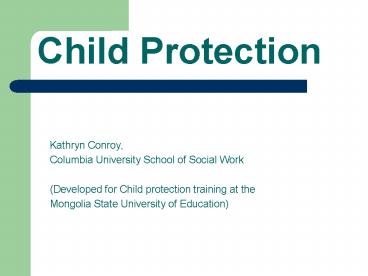Child Protection PowerPoint PPT Presentation
1 / 22
Title: Child Protection
1
Child Protection
- Kathryn Conroy,
- Columbia University School of Social Work
- (Developed for Child protection training at the
- Mongolia State University of Education)
2
Development of Child Protection
- Battered Child Syndrome, C. Henry Kemp, MD,
1960s - Child victims of non-accidental trauma
- Broader definitions today physical and sexual
abuse, physical, emotional, medical, neglect - General term Child Maltreatment
3
History of public intervention
- Generally begins with private citizens
- Moves to government regulations and funding
- Mongolias position on child maltreatment?
- Formal
- Informal
4
Physical Signs of Abuse
- Bruises in different stages of healing
- Marks belt, cord, teeth
- Grab marks on shoulders
- Burns cigarettes, cuff burn marks, patterns
- Fractures multiple or spiral
- Head injuries scalp, eye, nose, teeth, jaw
5
The Physically Abused Child
- Child may
- be startled when other children cry
- aggressive or withdrawn
- fear going home, fear parents or other adults
- exhibit mood swings, have habit disorders
- have low self esteem, obsessions
- have to keep covered, not remove coat or clothing
- attempt suicide.
6
Child Neglect
- Neglect may take many forms
- Physical
- Medical
- Emotional/psychological
- Educational
- Putting child at risk
7
Results of Physical Child Neglect
- Fetal Alcohol Syndrome
- Developmental lags
- Constant hunger
- Speech lag
- Poor hygiene
- Not dressed for the weather
- Inadequate medial care, not in school
- Inadequate supervision
8
Results of Emotional Neglect of Child
- Failure to thrive
- Child is aggressive or self destructive resulting
in injuries - Child is impaired intellectually or
psychologically - Child acts out not related to other stressors
9
The Neglected Child
- Child may be
- Always tired
- Always hungry
- Thumb sucking (older child), rocking or biting
- Frequently absent from school or day care
- Always sick
- Acts like a parent
- Child uses alcohol
10
Initial Assessment
- Safety of the child/children
- Help has to feel like Help!
- Etiology of abusive/neglectful behaviors
- Psychopathology
- Environmental Stress
- Social Learning
11
Abusive Adult Assessment
- Assess for possible history of, or behaviors
- Abused or neglected as a child
- Abuse of alcohol or drugs (60 of Mongolian CA/N
cases involved alcohol abuse) - Lack of emotional or social support
- Relationship problems
- Poor physical or mental health
- Situational crisis
- Unrealistic expectations
- Poverty or homelessness
- Poor role models for caring
- Social support for abuse
12
Abused/Neglected Child Assessment
- Physical indicators
- Bruises, burns, marks
- Apparent care hygiene, clothing, resources
- Emotional/Behavioral indicators
- Fear
- Ability to communicate
- Interactions with other
13
Family Assessment
- General family functioning
- Communication
- Competence
- Isolation
- Roles and responsibilities
14
Interventions
- All interventions begin with
- Immediate assessment of danger
- Remove child or
- Remove abuser and/or
- Add protection to family
- First responsibility is to ensure the safety of
the child/children
15
Interventions continued
- All immediate participants interviewed
individually - Parents interviewed separately note their
relationship - Children each interviewed separately depending on
age - Make sure to interview all children in family
16
Psychopathology
- Problem resides within the abuser
- Mental health assessment
- Safety of the child assessment
- Immediate mental health intervention
- Long term treatment plan
17
Environmental Stress
- Identification of the stress
- Assessment of possibility to relieve stress
- Stress reduction techniques
- Why stress leads to child maltreatment
- Other possible maladaptive behaviors
18
Social Learning
- Family history
- Lessons learned in childhood
- Investment in the lessons
- Ability to learn new lessons
- Resources for new lessons
19
Family Case Conferencing
- Family opportunity to solve own problems
- Inclusion of possible support network
- Location of conference
- Direct communication
- Valuing positive family/cultural traditions
- Agreement on service provision
- Accountability
20
Mongolian Child Welfare Legislation
- 1996 Law on Protection of Child Rights
- 1998 Social Welfare Law
- 1998 Health Law
- 1999 Labor Code
- 1999 Family Law
- 2002 Criminal Procedure Law
- 2004 Law Against Domestic Violence
21
Mongolian Child Welfare Issues
- Economic instability unemployment, poverty
- Increasing number of single headed families
- Acceptance of corporal punishment
- Increasing number of children in institutions
- Lack of day care, pre- school and school
- Street children
- Sexual exploitation and trafficking
22
Sources
- NYCPCC Professionals Handbook, Identifying and
reporting, Child Abuse and Neglect, New York
Society for the Prevention of Cruelty to
Children, 2003 - Field Guide to Child Welfare, Vol. 1, Foundations
of Child Protective Services, Rycus Hughes,
CWLA Press, Washington, D.C. 1998 - Netherlands Institute of Human Rights, Faculty of
Law, CRC Concluding Observations Mongolia, 2005 - Handbook for Working with Children and Youth,
Michael Ungar, ed., Sage Pub., CA, 2005

